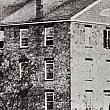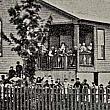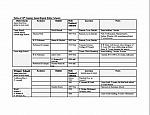
Coldbrook: District No. 6
by Diana Barrett
The Coldbrook District, as it was then commonly called, included that part of the city north of a line midway between Newberry and Mason Streets and east of the Grand River, and also extended one mile and a half north of the city limits.[1] The original building of the Coldbrook District was located near Taylor’s Tannery, which stood at the corner of Canal and Coldbrook Sts. The school was on the west side of Plainfield, south of E. Leonard, where later the Baldwin House was built. From there it was moved to the NE corner of Leonard and Plainfield where it stood until demolished to make room for the Sherman House, a hotel that stood from 1864 until it was destroyed by fire in 1885.
Coldbrook, voted, in 1851, to have four months of school and to have a ‘man teacher.’ Franklin Everett, who would later write The Memorials of the Grand River Valley, was employed at a salary of $55.32. Miss French who taught during the summer was paid $30.[2] The two-room school was un-graded until 1867, and there were two terms—winter and summer. The summer teacher was a woman who received $80. In the winter, when the larger boys attended, a man was required to enforce a fair amount of discipline, and he insisted upon a higher wage—we may assume the ratio was similar to that of 1851.
The last school built in the Coldbrook District was E. Leonard St. School, located at the corner of North St. The first brick school in Grand Rapids,[3] the two-story building, built in 1860, had stone foundations and cost $1500. (Have a drawing of school)
In those days the Native Americans still made their yearly trek to Grand Rapids to draw their annual payments from the government. During the spring they would camp on the bank of the Grand River near Leonard St. to fish. Intrigued by the Indian ways, the school children would play hooky and loiter about their camp.[4]
Not long after consolidation of the districts, the Board came to recognize that the rapid growth of the city would not soon abate, presenting a need for additional, costly school buildings. In 1873 the board formed a committee to suggest ways to meet the needs of the future in a practical and affordable manner. The superintendent reported the committee’s recommendations in the Board’s 1874 Annual Report, and in the newspaper.[5]
[1] Baxter, p 224
[2] Etten, William J. A Citizens’ History of Grand Rapids. A.P. Johnson Co., 1926, p 113.
[3] Note: The name ‘Old Page School’ was used in a story about the E. Leonard St. School in the GR Democrat, 9/30 1894, p 12. It appears to be the only reference to the school by that name. Loren M. Page had many sons who attended the school, five of whom fought in the Civil War. Julia A. Moore, a well-known Michigan poet at the time, wrote a poem about them, “The Brave Page Boys.” Fernando Street in NE Grand Rapids is named for Fernando Page who lost both his feet in the war. This may be the source of the “Old Page School” name.
[4] GR Democrat, 9/30 1894, p 12
[5] GR Eagle, 9/14/1874, p 1

 facebook
facebook














